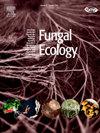热胁迫下真菌菌丝竞争过程中碳分配的变化
IF 1.9
3区 环境科学与生态学
Q3 ECOLOGY
引用次数: 0
摘要
木材腐烂担子菌在全球碳循环中起着至关重要的作用。褐腐菌和白腐菌的相对优势随着温度的变化而变化,这是了解变化环境中碳固存的关键。在这项研究中,我们测量了热胁迫下褐腐菌和白腐菌之间碳分配的变化,以评估它们竞争的结果。在液体培养基中培养25天后,热胁迫降低了Neolentinus(褐腐病)和Trichaptum(白腐病)菌株菌丝生物量,增加了CO2排放量。然而,在热胁迫下,Trichaptum菌株对代谢物生产和未知组分的碳分配发生了显著变化,而Neolentinus菌株的变化则不太明显。Neolentinus和Trichaptum之间的竞争从最佳温度下的僵局转变为热胁迫下Neolentinus的优势。这些发现表明,与毛haptum相比,Neolentinus具有更强的耐热性,在热胁迫下保持更稳定的代谢活性。本文章由计算机程序翻译,如有差异,请以英文原文为准。
Carbon allocation shifts during fungal mycelial competition under the heat stress
Wood-decaying basidiomycetes play crucial roles in global carbon cycling. The relative dominance of brown rot and white rot fungi, which vary with temperature, is key to understanding carbon sequestration in a changing environment. In this study, we measured changes in carbon allocation between brown and white rot fungi under heat stress to assess the outcome of their competition. After 25 days of incubation in liquid media, heat stress reduced hyphal biomass and increased CO2 emissions in both Neolentinus (brown rot) and Trichaptum (white rot) strains. However, carbon allocation to metabolite production and unknown fractions shifted markedly in Trichaptum strains under heat stress, whereas changes in Neolentinus strains were less pronounced. Competition between Neolentinus and Trichaptum shifted from a deadlock at optimal temperature to Neolentinus's dominance under heat stress. These findings suggest that Neolentinus is more heat-tolerant compared to Trichaptum, maintaining more stable metabolic activity under heat stress.
求助全文
通过发布文献求助,成功后即可免费获取论文全文。
去求助
来源期刊

Fungal Ecology
环境科学-生态学
CiteScore
5.80
自引率
3.40%
发文量
51
审稿时长
3 months
期刊介绍:
Fungal Ecology publishes investigations into all aspects of fungal ecology, including the following (not exclusive): population dynamics; adaptation; evolution; role in ecosystem functioning, nutrient cycling, decomposition, carbon allocation; ecophysiology; intra- and inter-specific mycelial interactions, fungus-plant (pathogens, mycorrhizas, lichens, endophytes), fungus-invertebrate and fungus-microbe interaction; genomics and (evolutionary) genetics; conservation and biodiversity; remote sensing; bioremediation and biodegradation; quantitative and computational aspects - modelling, indicators, complexity, informatics. The usual prerequisites for publication will be originality, clarity, and significance as relevant to a better understanding of the ecology of fungi.
 求助内容:
求助内容: 应助结果提醒方式:
应助结果提醒方式:


